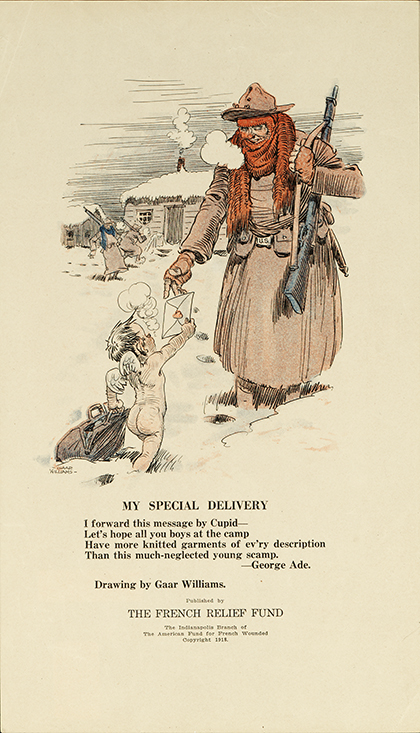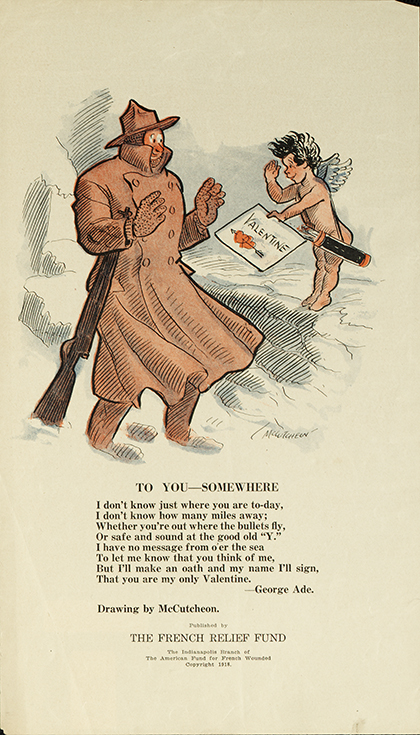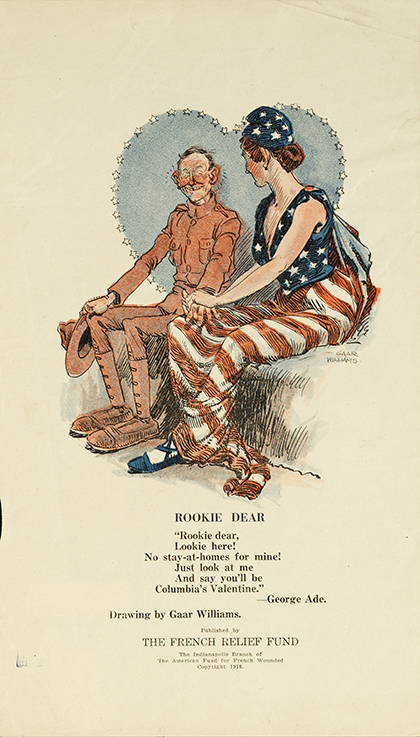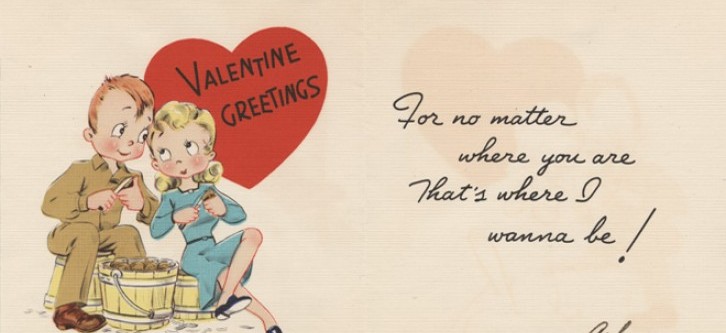During this month of February, in the second year of observing the centennial of World War I, it is particularly gladdening to know that during the cold winter of the final year of brutal fighting, there were brave, bare-bottomed Cupids who delivered valentines to our soldiers in the trenches.

In The Eberly Family Special Collections Library at the Penn State Libraries there is a series of broadsides that were produced for the American Fund for French Wounded, which was founded in 1915 by American women living abroad to purchase medical supplies and provide relief to wounded soldiers in France during World War I. As the war dragged on, the group expanded to help rebuild French homes and buy supplies. The examples shown here were all produced for the Indianapolis Branch under the title French Relief Fund, and they depict scenes from the home front and the battlefront, accompanied by humorous poems. American watercolorist Mrs. Mamie Bybee Milliken originated the idea of these comic valentines with patriotic themes. (Girls were also a popular theme, of course.) Indiana authors and artists like William Gaar cooperated in the project, and Milliken was able to have the broadsides ready for families and sweethearts to send off to the boys “over there” for February 14, 1918. They were issued as a portfolio set of twelve. (Penn State owns only ten. A complete set can be found at the Indiana Historical Society.)
The broadside “My Special Delivery” (above), illustrated by American artist and political cartoonist Gaar Williams (1880-1935), depicts Cupid with a satchel, handing a valentine to a U.S. soldier bundled up in a long coat, scarf, fingerless gloves, and hat, standing in the snow with a rifle slung over his shoulder. A poem by George Ade (1866-1944), is printed below the illustration: “I forward this message by Cupid/Let’s hope all you boys at the camp/Have more knitted garments of ev’ry description/Than this much-neglected young scamp.”

Artist John Tinney McCutcheon (1870-1949) created the broadside “To You Somewhere,” depicting Cupid handing a valentine and saluting to a surprised and delighted soldier who is standing in the snow. A poem by Georg Ade appears below: “I don’t know just where you are to-day,/I don’t know how many miles away;/Whether you’re out where the bullets fly,/Or safe and sound at the good old ‘Y’./I have no message from o’er the sea/To let me know that you think of me,/But I’ll make an oath and my name I’ll sign,/That you are my only Valentine.”

William Gaar and George Ade teamed up again to produce “Rookie Dear,” which depicts Columbia wearing a splendidly patriotic ensemble of a blue cap and blouse with white stars, a red and white striped long skirt, and blue shoes. She is seated next to a blushing soldier in uniform, his hand held in both of hers. “Rookie dear,/Lookie here!/No stay-at-homes for mine!/Just look at me/And say you’ll be/Columbia’s Valentine.”
More of the French Relief Fund broadsides can be seen in the Penn State Libraries digital site called “War Posters: World War I, World War II, Anti-Vietnam War Protest, and Black Militant Posters” found at http://www.libraries.psu.edu/psul/digital/warposters.html.

As a casual collector of old valentines myself, I prefer the thrill of a serendipitous discovery rather than engaging in dogged and purposeful Internet hunts. It’s particularly satisfying to thumb through a pile of greeting cards at an antique store and discover a favorite category of valentine, such as those produced for servicemen and women. My modest collection does not include cards from World War I, but I do have examples from World War II, with images of Victory Gardens, Uncle Sam, and soldiers peeling potatoes while on KP duty. Some of them incorporate patriotic slogans such as “Yours for Victory.”

It’s even more rewarding for a flea-market shopper like me to find four valentines that were signed by the same fond sender, such as the one shown here from “Arlene” (in other signatures known as “Your Lovin’ Wife, X Arlene X”). Without the envelopes (always a bonus for a collector), the identity of Arlene’s lovin’ husband has been lost, but we do know that he must have carried these cards home from the service, saved them, and perhaps cherished them for the rest of his days. There’s something poignant about such valued remnants of a life ending up in a bin with other unmoored cards in central Pennsylvania, available for sale to strangers. But collectors like me are excited to fall for the considerable charms of such ephemeral objects that are so representative of a place and a time and that so vividly define an era.
(Note: this article was originally published in February 2016.)







